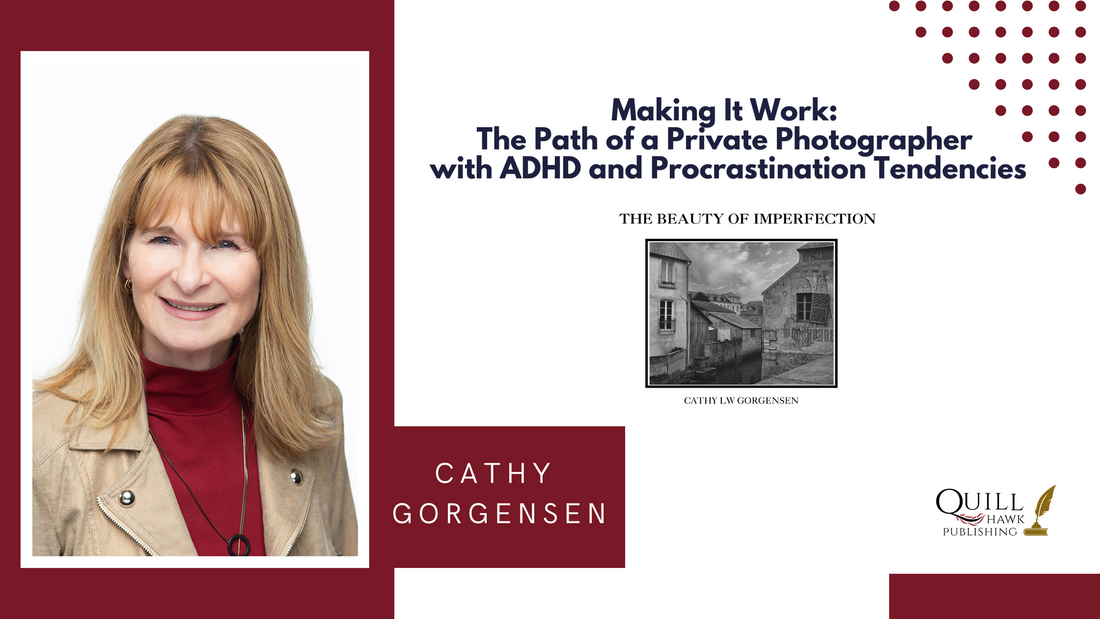Making it Work: The Path of a Private Photographer with ADHD and Procrastination Tendencies by Cathy Gorgensen, Author of The Beauty of Imperfection
In the ever-evolving world of photography, one thing is clear: there’s no single way to make it. For some, it’s about social media presence, crafting the perfect Instagram feed, or becoming a YouTube sensation. But for others, especially those who are very private, possibly living with ADHD, and prone to procrastination, the path may look entirely different. You don’t have to follow the crowd to sell your photography or publish a book. With your unique attributes, there’s a way forward that works for you.
Understanding Your Strengths and Challenges
The first step to making it work is understanding and accepting your reality. Your ADHD brain, which others might see as chaotic, is actually a gift. ADHD can make you hyper-focused on what you’re passionate about, meaning when photography captures your attention, you likely immerse yourself in it deeply. That passion and focus are what will set your work apart.
Of course, ADHD comes with challenges—procrastination, distraction, and overwhelm can sabotage your progress. You may have grand ideas for projects but struggle to get started, let alone finish them. The temptation to put things off is constant. Combine that with an aversion to social media, a medium many photographers rely on, and it might seem like the odds are stacked against you. But they aren’t.
Embrace that your brain works differently, and that’s not only okay—it’s an advantage. You need to find the right systems and strategies to harness it.
Building a Strategy That Works for You
The traditional route of marketing photography through social media might not be appealing to you, and that’s perfectly fine. Many artists thrive outside the social media spotlight by relying on other marketing channels that cater to their strengths. Here’s how you can use your attributes to carve out a path for yourself:
1. Limited but Focused Social Media Presence
While managing multiple platforms might feel overwhelming, consider a minimalistic approach. You don’t need to be everywhere at once. Pick one platform, like Instagram, and set realistic expectations. Use it as a portfolio rather than a constant update stream. You can schedule posts in advance, limiting the need for constant interaction. Tools like Buffer or Hootsuite can help you automate the process, freeing you from daily distractions. This limited presence can still help you gain visibility while maintaining your privacy.
2. Leverage Your Network
Even if you’re private, you likely have a small circle of trusted friends, family, or colleagues who appreciate your photography. Use this network to get the word out. They can help spread the word about your book and photography services. Word-of-mouth is still one of the most powerful tools, especially for someone who prefers to stay behind the scenes.
Consider forming relationships with local businesses, galleries, or even online niche communities where your work can be displayed. Your photography doesn’t have to be plastered online to find its audience.
3. Create a Personal Website
Instead of leaning heavily on social media, focus on a personal website. A website is a quiet, controlled space where you can showcase your work, sell prints, and promote your photography book without worrying about constant engagement. You can direct people there through word-of-mouth, business cards, or other non-social media avenues.
Given your potential for hyperfocus, create a beautifully designed website that reflects your personality and art. This will be your digital home—you can direct anyone interested in your work there. You can build it incrementally, avoiding the overwhelming task of doing everything at once.
4. Time Management Hacks for the Procrastinator
ADHD often comes with chronic procrastination, but it’s not unbeatable. One way to overcome it is by breaking tasks into smaller, more manageable steps. For example, instead of thinking, “I need to write my photography book,” try setting a goal like, “I’ll spend 15 minutes brainstorming chapter ideas.” Breaking tasks down reduces the feeling of being overwhelmed and allows you to progress bit by bit.
Use tools like timers (such as the Pomodoro Technique) to permit yourself to focus for short bursts of time. This helps bypass the ADHD tendency to get lost in unrelated tasks. After all, once you start, you’re likely to get into the flow, especially if it’s something you care about.
5. Set Realistic Deadlines
Deadlines are important, but they can also become a source of stress when you're a procrastinator. Be kind to yourself and set achievable deadlines. Instead of telling yourself that your photography book has to be published in three months, aim for longer timelines with built-in flexibility. That way, if procrastination creeps in, you’ll still have time to meet your goals.
Use reminders and digital calendars to nudge yourself forward gently. Even small progress is progress, and by setting deadlines that work for you, you reduce the anxiety that often leads to more procrastination.
The Photography Book: Telling Your Story
Publishing a photography book is a significant milestone, but for someone with ADHD and procrastination tendencies, it’s essential to approach it methodically. Your photography tells a story, but so does the process of creating the book itself.
1. Start with a Concept
Think about the overarching theme of your book. What story do you want your images to tell? A focused concept can help you stay on track and prevent the project from feeling too vast. Once you define the concept, your photography style, whether it’s nature, urban landscapes, or portraits, will naturally lend itself to a cohesive book.
2. Don’t Aim for Perfection
Perfectionism is often the enemy of progress. Instead of getting stuck trying to make every photo and every page flawless, allow yourself to create a book that reflects where you are right now as a photographer. Your first book doesn’t have to be your magnum opus; it’s a stepping stone in your artistic journey.
3. Work with Professionals
Consider collaborating with a designer or editor who can help bring your vision to life. This will relieve some of your pressure and ensure that your procrastination won’t stall the project indefinitely. You may even find that working with someone else keeps you accountable and motivated to finish.
4. Success on Your Terms
It's entirely possible to become a photographer and publish a book while managing ADHD, procrastination, and an aversion to social media. The key is to play to your strengths, use the tools that work for you, and avoid comparing your journey to others. Success doesn’t require being a social media star or having perfect productivity habits. It’s about finding a balance between your private nature and your passion for photography, then taking small, consistent steps to share your work with the world.
By embracing your unique traits, building systems that help you overcome procrastination, and staying true to your artistic vision, you can sell your photography and successfully publish your first book. The journey may not look like anyone else’s, but that’s what will make it so special.
To learn more about Cathy Gorgensen, visit:
https://quillhawkpublishing.com/pages/author/cathy-waite-gorgensen

Autographed copies of The Beauty of Imperfection are available now:
https://quillhawkpublishing.com/products/the-beauty-of-imperfection





